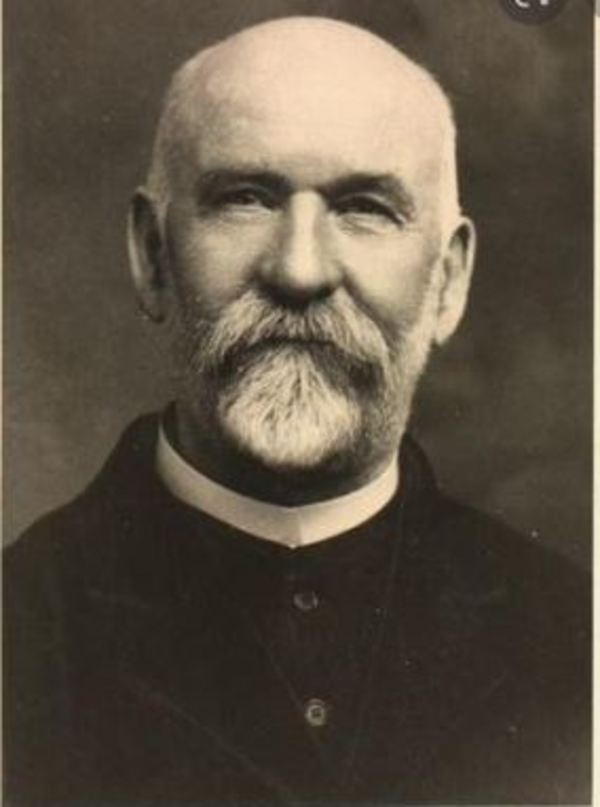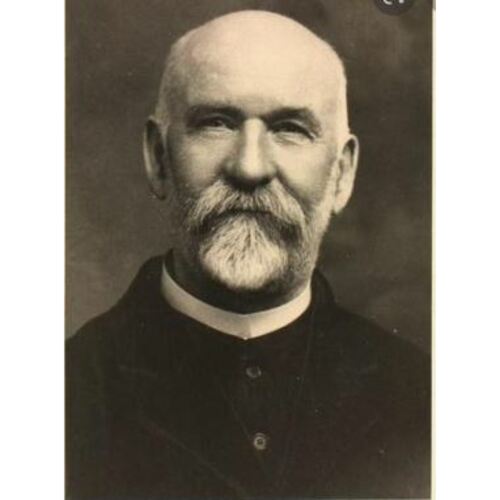
Source: Link
HORNER, RALPH CECIL, farmer, Methodist clergyman, revivalist, and holiness bishop; b. 22 Dec. 1853 near Shawville, Lower Canada, eldest son of James Horner and Ellen Richardson; m. 27 Nov. 1890 Annie E. McDonald in Ottawa, and they had at least four daughters and three sons; d. 12 Sept. 1921 near Ivanhoe, Ont.
Of Anglican, northern Irish descent, Ralph C. Horner was a third-generation farmer on the Quebec side of the Ottawa valley across from Renfrew. His father had died when he was 16, and he had been obliged to abandon his schooling to run the farm. Immediately after his spiritual conversion at a Methodist camp meeting nearby in July 1876, he received a second blessing of entire sanctification or complete holiness [see James Caughey*] and began to serve as a lay revivalist at religious gatherings in his neighbourhood. He testified to the gifts God had granted him, particularly holiness. He later achieved through prayer a third blessing from the Holy Spirit of a pentecostal “Tongue of Fire,” which empowered him to evangelize. “The extra gift for soul winning has been the aggressive element in my experience,” he wrote in his memoirs. “It brought all the dormant powers of my soul into activity, and energized all my faculties for efficiency in the vineyard of the Lord.”
In 1882 Horner became a probationer in the Methodist Church of Canada to facilitate his labours as an evangelist – he always denied being called to regular pastoral duties. He served his first year on the Clarendon circuit south of Renfrew County, and from 1883 to 1885 he studied theology at Victoria University in Cobourg. During his last probationary appointment, in 1885–86 to Cobden and Locksley in Renfrew, he spent time in Philadelphia obtaining a bachelor of oratory from the National School of Elocution and Oratory. After a short but public disagreement with officials of the church’s Montreal Conference over the nature of ordination – the Methodists had no irregular or special ordination to become an evangelist – he was ordained on 29 May 1887. Nevertheless, he was appointed one of the conference’s evangelists for the next three years. The church had established the positions to avoid the disciplinary and theological difficulties often associated with independent, transient preachers. No revivalist could preach within a jurisdiction without permission from the conference and the local circuit.
With his highly emotional and enthusiastic preaching, emphasis on entire sanctification and the pentecostal third blessing, and reliance on wild physical manifestations such as shouting, crying, flailing about, and prostration, Horner was soon censored by his superiors and Methodists intent on keeping the denomination respectable. As well, he disobeyed established regulations by evangelizing wherever he decided he could be effective, even if his “flaming” revivals interfered with the work of the local clergy. To discipline him, the conference stationed him in 1890–91 to the Portage-du-Fort circuit, near Shawville. However, he hired a supply minister in July 1890 and continued his independent evangelism. Because he had converted thousands in the Ottawa valley and adjoining territories, and had also published several useful religious books, his unconventional conduct was overlooked and he was appointed a conference evangelist for 1891–92 and again for 1892–93. In November 1890 he had married the 23-year-old Annie McDonald, who had been an assistant in revivalist services he had visited and who would help him in his evangelism.
In 1893, in response to further complaints about Horner’s conduct (including his hiring untrained and unlicensed lay preaching assistants) and at his own request, the conference’s stationing committee left him without an appointment. With his lay preachers, Horner bought a former Baptist church in Ottawa in order to enlarge and formalize his work. The following year he was stationed to the Combermere circuit in Renfrew, but his refusal to go and his increasing unwillingness to follow the doctrine and discipline of the church forced it to depose him in 1895. Horner, whose religious tracts included studies of John Wesley and Methodist holiness, argued that the church opposed the preaching of the great Wesleyan doctrine of entire sanctification. Initially he had been supported by the conservative general superintendent, Albert Carman*, but Carman could never accept any repudiation of disciplinary authority. Moreover, the church’s powerful liberal wing refused to condone Horner’s excesses and criticisms of institutional Methodism.
By the early 1890s Horner had united with like-minded Methodist clergy, including Nelson Burns* and Albert Truax, and laity in espousing holiness principles. Among Methodists, in 1895 they reorganized the Canadian Holiness Association (founded in 1879) to form the Christian Association. In 1894 Horner had become a member of the extreme holiness organization, the Wesleyan Methodist Connection of America; after his expulsion he unsuccessfully attempted to have it incorporated in Canada. In 1897 he founded the Holiness Movement Church in Canada, with himself as bishop. The church attracted several thousand disenchanted Methodists, Baptists, and other evangelical Christians in the Renfrew–Montreal–Kingston triangle. The denomination soon gained support as well in Ontario’s Bruce peninsula and in western Canada, where many members migrated. It operated overseas missions (especially in Egypt) and opened a publishing house and seminary in the Horners’ residence in Ottawa. Beginning in 1897, the denomination published the Holiness Era journal. In Ontario, Hornerites were normally farmers or workers who were facing rural depopulation or economic decline. They also felt threatened by aggressive Roman Catholicism and, like other conservative Protestants, they mistrusted liberal theological modernism.
To his followers, Horner’s self-possessed style, espousal of holiness, and willingness to confront the apparently lax “professors of religion” were mesmerizing. In his sermons and writings he claimed to have known infusions of power that enabled him to convert sinners. Speaking about 1899 on a favourite passage, Micah 3:8 (“But truly I am full of power by the Spirit of the Lord”), he recalled his first experience: “On a Saturday evening, while in my tent waiting for a victory for the Sabbath, this text came, and with it a cyclone of power; I could not sit, stand or lie; I was in every shape and form, and the tent, 40 x 60, seemed too small to hold me. I longed to be outside to have room. . . . I preached the next day on ‘Truly I am full of power.’ All the opposers ran to the altar for mercy.”
Horner always considered himself a faithful follower of Wesley and a defender of scriptural Christianity. Although not a premillennial Adventist, he believed the world should be prepared for the second coming. Most important, he argued that every sanctified person should seek the additional blessing of the pentecostal baptism of fire, which empowered the individual to prevail before God on behalf of sinners, and thereby help convert the world. Because Horner felt these standard Wesleyan principles were being violated, even within his own denomination, in 1916 the bald, white-bearded bishop and a substantial minority of members in the Holiness Movement Church formed the Standard Church of America, with headquarters and a publishing house in Brockville, Ont. Much of the division, in fact, had centred on Horner’s style of episcopacy and his inability to accept advice from new generations of holiness leaders. During the early 20th century, many holiness congregations were breaking apart and re-forming around specific leaders and issues, including the implications of pentecostalism, especially speaking in tongues.
An evangelist to the end, Ralph C. Horner died in 1921 during a camp meeting he was conducting near Ivanhoe, Ont., north of Belleville. He was buried in Merivale Cemetery near Ottawa.
Ralph Cecil Horner’s publications include Pentecost (Toronto, 1891); Notes on Boland; or, Mr. Wesley and the second work of grace (Toronto, 1893); Fragments from the feast; or, 18 sermons, ed. E. T. Campbell (Belleville, Ont., 1902); Bible doctrines (2v., Ottawa, 1908–9); The doctrines of the Standard Church of America defined and proved from Scripture . . . (Brockville, Ont., n.d.); and Ralph C. Horner, evangelist: reminiscences from his own pen; also reports of five typical sermons, issued posthumously by his widow Annie E. [McDonald] Horner (Brockville, [1926?]). Issues of the Holiness Era (Ottawa) from 1897, 1899, and 1900 are available on microfilm at UCC-C.
ANQ-Q, M122/28, 13 juill. 1854. AO, RG 22-354, no.10387; RG 80-5-0-175, no.2132; RG 80-8-0-818, no.15841. NA, RG 31, C1, 1901, Ottawa, Wellington Ward, div.9: 18 (mfm. at AO). Ottawa Evening Journal, 16 Sept. 1921. Canadian men and women of the time (Morgan; 1912). G. H. Cornish, Cyclopædia of Methodism in Canada . . . (2v., Toronto and Halifax, 1881–1903), 2. Directory, Ottawa, 1901. Marilyn Fardig Whiteley, “Cyclones of power/noisy display: the holiness conflict in the Methodist Church,” Canadian Methodist Hist. Soc., Papers (Toronto), 11 (1997): 11–25. B. R. Ross, “Ralph Cecil Horner: a Methodist sectarian deposed, 1887–1895,” Canadian Church Hist. Soc., Journal (Toronto), 19 (1977): 94–103. Neil Semple, The Lord’s dominion: the history of Canadian Methodism (Montreal and Kingston, Ont., 1996).
Cite This Article
Neil Semple, “HORNER, RALPH CECIL,” in Dictionary of Canadian Biography, vol. 15, University of Toronto/Université Laval, 2003–, accessed April 4, 2025, https://www.biographi.ca/en/bio/horner_ralph_cecil_15E.html.
The citation above shows the format for footnotes and endnotes according to the Chicago manual of style (16th edition). Information to be used in other citation formats:
| Permalink: | https://www.biographi.ca/en/bio/horner_ralph_cecil_15E.html |
| Author of Article: | Neil Semple |
| Title of Article: | HORNER, RALPH CECIL |
| Publication Name: | Dictionary of Canadian Biography, vol. 15 |
| Publisher: | University of Toronto/Université Laval |
| Year of revision: | 2005 |
| Access Date: | April 4, 2025 |



